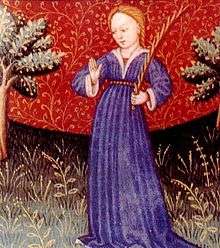Virgo (astrology)
| Virgo | |
|---|---|
 | |
|
| |
| Zodiac symbol | Virgin |
| Duration (tropical, western) | August 23 – September 23 (2018, UT1)[1] |
| Constellation | Virgo |
| Zodiac element | Earth |
| Zodiac quality | Mutable |
| Sign ruler | Mercury |
| Detriment | Jupiter (ancient), Neptune (modern) |
| Exaltation | Mercury |
| Fall | Venus |
|
| |
| Astrology |
|---|
 New millennium astrological chart |
| Background |
| Traditions |
| Branches |
|
|
Virgo (♍) (Greek: Παρθένος, Parthenos), is the sixth astrological sign in the Zodiac. It spans the 150-180th degree of the zodiac. Under the tropical zodiac, the Sun transits this area on average between August 23 and September 22,[2] and the Sun transits the constellation of Virgo from approximately September 16 to October 30.[3] Individuals born during these dates, depending on which system of astrology they subscribe to, may be called Virgos[4] or Virgoans.[5] The symbol of the maiden is based on Astraea. In Greek mythology, she was the last immortal to abandon Earth at the end of the Silver Age, when the gods fled to Olympus – hence the sign's association with Earth.[6]
Origins
The constellation Virgo has multiple different origins depending on which mythology is being studied. Most myths generally view Virgo as a virgin/maiden with heavy association with wheat. In Greek and Roman mythology they relate the constellation to Demeter, mother of Persephone, or Proserpina in Roman, the goddess of the harvest.[7] However, some tell tales of the Greek story of Parthenos, which means virgin in Greek, which explains how the actual constellation Virgo came to be.[8]
In this story Parthenos is the daughter of Staphylus and Chrysothemis, and sister to Rhoio and Molpadia. Rhoio had been impregnated by the Greek god Apollo, once her father had found out that she was pregnant he assumed it was from some random suitor and was greatly ashamed. As punishment her father locked her in a box and threw her in a river. After the terrible fate of their sister, Parthenos and Molpadia were very nervous to anger their father in fear of his terrible wrath. On one evening, Staphylus left his two daughters in charge of a bottle of wine, back in that time a very valuable item indeed. When they both accidentally fell asleep one of their swine broke in and broke the bottle. Fearing their fathers wrath, the two sisters fled to a nearby cliff and threw themselves off. Because of Apollo's previous relations with their sister Rhoio, Apollo saved the two from the cliff and delivered them to the safety of nearby cities in Cherronseos. Molpadia ended up in Castabus where she changed her name to Hemithea and was worshipped as a local goddess for many years. Parthenos ended up in Bubastus where she was also worshipped as a local goddess. According to another story, Parthenos was a daughter of Apollo who died at a very young age and after her death Apollo made the constellation after her.[8]
While this is only one story in one myth of the origin of Virgo, she is seen throughout all matter of myths. In the Egyptian myths, when the constellation Virgo was in the sun was when the start of the wheat harvest again thus connecting Virgo back to the wheat grain. She also has various connections with the India goddess Kanya, and even the Virgin Mary.[8]
Notes
Works cited
- Allen, Richard Hinckley (1963). Star Names: Their Lore and Meaning. Nineola: Dover Publications.
- Astronomical Applications Department (2011). Multiyear Computer Interactive Almanac. 2.2.2. Washington DC: US Naval Observatory. Longitude of Sun, apparent geocentric ecliptic of date, interpolated to find time of crossing 0°, 30°....
- Atsma, Aaron J. (c. 2015). "ASTRAEA : Greek goddess of justice".
- Rigoglioso, Marguerite (2009). "Artemis's Divine Birth Priestesshood". The Cult of Divine Birth in Ancient Greece. New York: Palgrave Macmillan.
- Shapiro, Lee (2011). "The Real Constellations of the Zodiac". International Planetarium Society. Retrieved September 9, 2018.
- "Virgo (constellation)". Encyclopedia Britannica. n.d. Retrieved 2018-09-20.
- "Virgo". Oxford Dictionaries. n.d. Retrieved April 3, 2016.
- "Virgoan – Dictionary definition and pronunciation - Yahoo! Education". Education.yahoo.com. Archived from the original on October 8, 2012. Retrieved August 15, 2012.